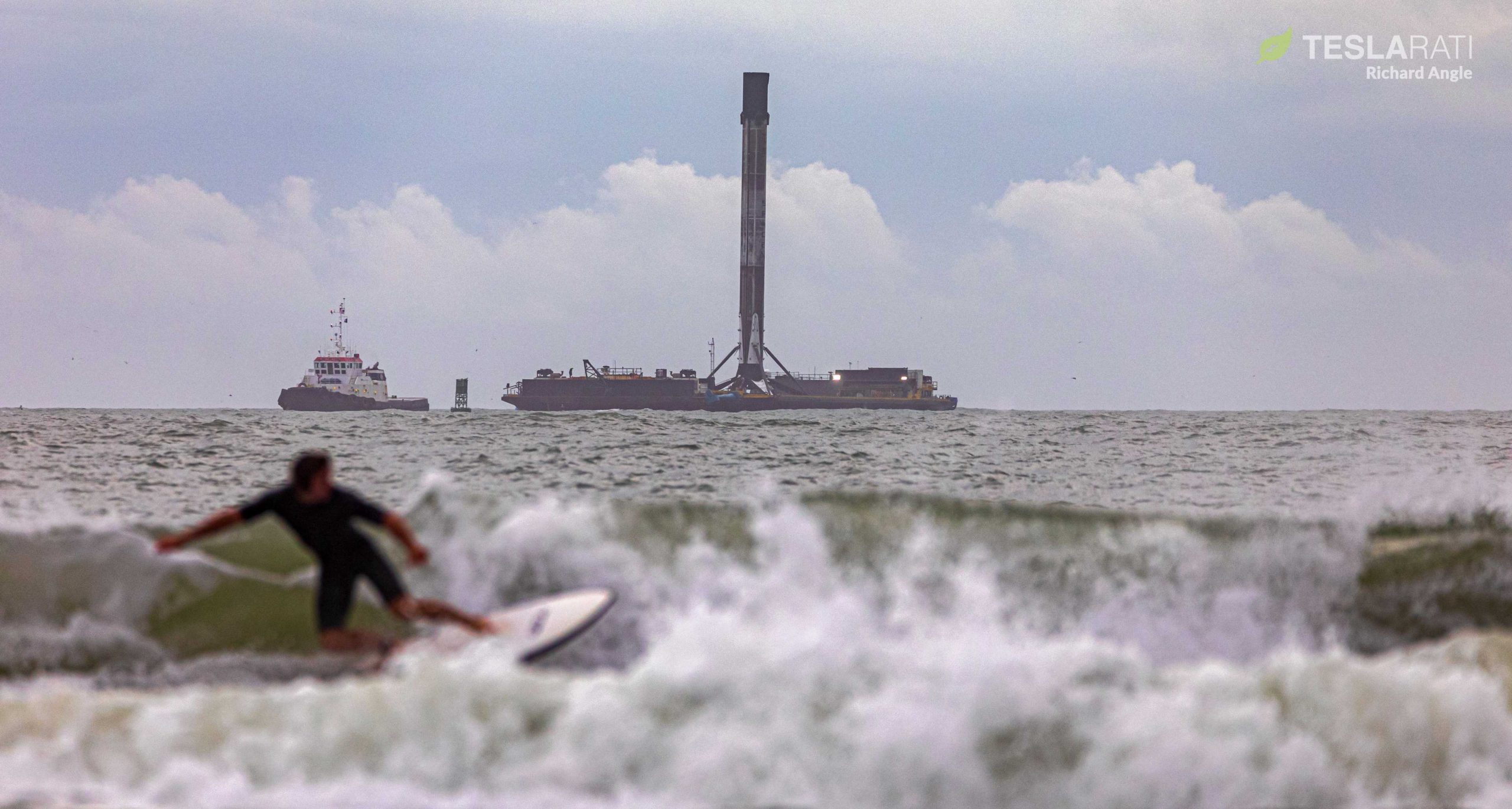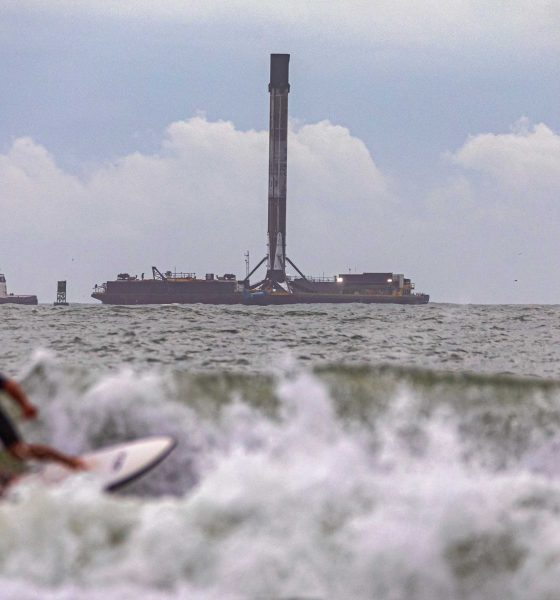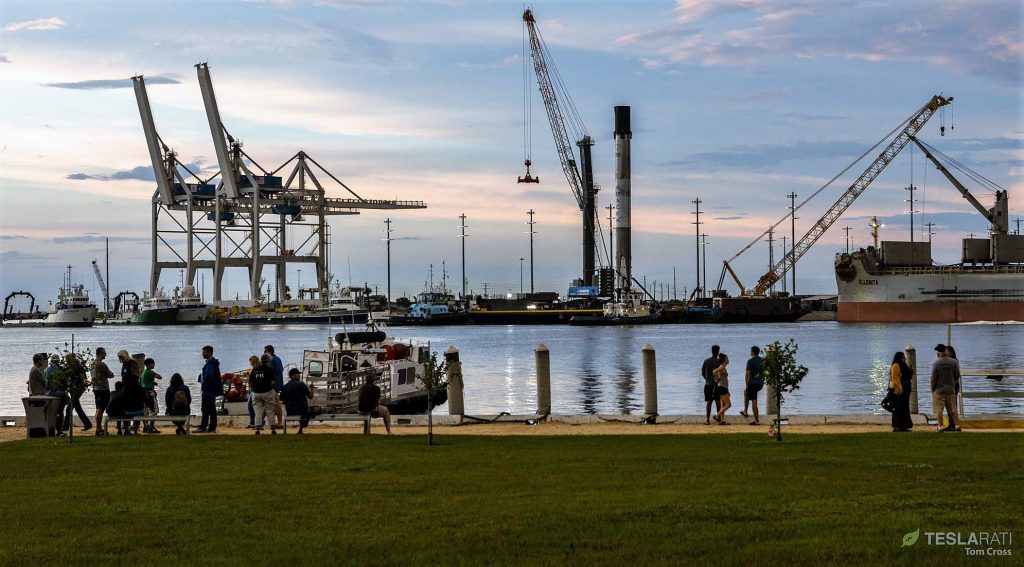

News
SpaceX Falcon 9 launch and landing imminent as drone ship heads to sea
SpaceX’s next Falcon 9 launch and landing is well into the late stages of preparation, leaving the company approximately 24-48 hours away from its next mission to orbit. To support the surprise ocean landing, a drone ship has already been dispatched and recently departed Port Canaveral.
After a frenetic week of preparation, tugboat Hawk departed with drone ship Of Course I Still Love You (OCISLY) on December 1st, preparing for its second recovery attempt in roughly three weeks and SpaceX’s second drone ship landing after a rare, six-month rocket landing lull. In the days leading up to the anticipated departure, workers could be seen performing a routine procedure often nicknamed a “FOD-walk” in which a given surface is scoured for Foreign Object Debris (FOD). This is most commonly performed on runways (including aircraft carriers) and attempts to mitigate or fully prevent damage from rocks and other small debris.
In the case of Falcon booster landings, the rocket’s Merlin 1D engine exhaust velocity is just shy of 3000 m/s (6700 mph), meaning that a tiny rock or leftover rocket piece could almost immediately become a high-subsonic or supersonic projectile in the seconds before touchdown. The drone ship itself is most at risk, but those theoretical projectiles could potentially bank off the platform’s exhaust shields and hit the booster itself, causing far costlier damage.
And hence the FOD-walk pictured above. Once complete, OCISLY was cleared for departure and has since made it about 75% of the way to its planned landing zone coordinates. SpaceX is currently scheduled to launch Cargo Dragon resupply mission CRS-19 on a Falcon 9 rocket no earlier than 12:51 pm EST (16:51 UTC) on December 4th, although a specific weather condition may delay the instantaneous window by 24 hours. Hawk and OCISLY should thus arrive on station one or two days before launch.
As it turns out, this Falcon 9 landing is a bit of mystery: it’s unclear why exactly SpaceX has decided to land the booster at sea instead of the usual Landing Zone recoveries that have followed most recent Cargo Dragon launches. Typically, the low insertion orbit (~200 km x ~390 km) and relatively low mass of Cargo Dragon (less than 10 tons or 22,000 lb) means that Falcon 9 has (literally) tons of propellant left over, giving it the margins needed to flip around, cancel out a huge amount of horizontal velocity, and boost 100+ km (62+ mi) back to shore.
Instead, new Falcon 9 booster B1058 is scheduled to land aboard drone ship OCISLY some 350 km (220 mi) downrange, an unusual distance. For reference, SpaceX’s May 2019 CRS-17 mission is the only time Falcon 9 has landed at sea after a CRS launch since CRS-8, the rocket’s first successful drone ship recovery. That scenario was forced because LZ-1/2 had coincidently been showered in Crew Dragon debris after C201 exploded during testing. Even then, OCISLY was stationed just 20 or so kilometers offshore, meaning that Falcon 9 B1056 still performed a routine Return To Launch Site (RTLS) landing in spirit.

In short, the ~350-km-downrange landing plan suggests that this Cargo Dragon launch may have a much smaller propellant margin than essentially every similar mission preceding it. This could be explained in a few ways. Maybe after Falcon 9 B1050’s surprise landing failure, SpaceX decided that all new Falcon 9 boosters will attempt drone ship landings after their first flight, minimizing the risk to Cape Canaveral in the event of a CRS-16 repeat. Another possibility, Crew Dragon capsule C205 – scheduled to support the spacecraft’s In-Flight Abort (IFA) test late this month or early next – may still be close to the Cape’s Landing Zones, another reason to avoid even the slightest chance of a catastrophic Falcon landing failure.

Finally, it’s also possible that CRS-19 will follow in the footsteps of CRS-18, which sported a prototype Falcon 9 upper stage designed to push the enveloped of its orbital longevity. Falcon 9 B1056 still managed to land at LZ-1 after CRS-18, but a more ambitious follow-on test could potentially require much more propellant, accounting for the drone ship’s position further downrange. With any luck, we’ll find out more later today during SpaceX, NASA, and the US Air Force’s routine pre-launch press conference – stay tuned!
Check out Teslarati’s Marketplace! We offer Tesla accessories, including for the Tesla Cybertruck and Tesla Model 3.

News
Tesla FSD fleet is nearing 7 billion total miles, including 2.5 billion city miles
As can be seen on Tesla’s official FSD webpage, vehicles equipped with the system have now navigated over 6.99 billion miles.

Tesla’s Full Self-Driving (Supervised) fleet is closing in on almost 7 billion total miles driven, as per data posted by the company on its official FSD webpage.
These figures hint at the massive scale of data fueling Tesla’s rapid FSD improvements, which have been quite notable as of late.
FSD mileage milestones
As can be seen on Tesla’s official FSD webpage, vehicles equipped with the system have now navigated over 6.99 billion miles. Tesla owner and avid FSD tester Whole Mars Catalog also shared a screenshot indicating that from the nearly 7 billion miles traveled by the FSD fleet, more than 2.5 billion miles were driven inside cities.
City miles are particularly valuable for complex urban scenarios like unprotected turns, pedestrian interactions, and traffic lights. This is also the difference-maker for FSD, as only complex solutions, such as Waymo’s self-driving taxis, operate similarly on inner-city streets. And even then, incidents such as the San Francisco blackouts have proven challenging for sensor-rich vehicles like Waymos.
Tesla’s data edge
Tesla has a number of advantages in the autonomous vehicle sector, one of which is the size of its fleet and the number of vehicles training FSD on real-world roads. Tesla’s nearly 7 billion FSD miles then allow the company to roll out updates that make its vehicles behave like they are being driven by experienced drivers, even if they are operating on their own.
So notable are Tesla’s improvements to FSD that NVIDIA Director of Robotics Jim Fan, after experiencing FSD v14, noted that the system is the first AI that passes what he described as a “Physical Turing Test.”
“Despite knowing exactly how robot learning works, I still find it magical watching the steering wheel turn by itself. First it feels surreal, next it becomes routine. Then, like the smartphone, taking it away actively hurts. This is how humanity gets rewired and glued to god-like technologies,” Fan wrote in a post on X.
News
Tesla starts showing how FSD will change lives in Europe
Local officials tested the system on narrow country roads and were impressed by FSD’s smooth, human-like driving, with some calling the service a game-changer for everyday life in areas that are far from urban centers.

Tesla has launched Europe’s first public shuttle service using Full Self-Driving (Supervised) in the rural Eifelkreis Bitburg-Prüm region of Germany, demonstrating how the technology can restore independence and mobility for people who struggle with limited transport options.
Local officials tested the system on narrow country roads and were impressed by FSD’s smooth, human-like driving, with some calling the service a game-changer for everyday life in areas that are far from urban centers.
Officials see real impact on rural residents
Arzfeld Mayor Johannes Kuhl and District Administrator Andreas Kruppert personally tested the Tesla shuttle service. This allowed them to see just how well FSD navigated winding lanes and rural roads confidently. Kruppert said, “Autonomous driving sounds like science fiction to many, but we simply see here that it works totally well in rural regions too.” Kuhl, for his part, also noted that FSD “feels like a very experienced driver.”
The pilot complements the area’s “Citizen Bus” program, which provides on-demand rides for elderly residents who can no longer drive themselves. Tesla Europe shared a video of a demonstration of the service, highlighting how FSD gives people their freedom back, even in places where public transport is not as prevalent.
What the Ministry for Economic Affairs and Transport says
Rhineland-Palatinate’s Minister Daniela Schmitt supported the project, praising the collaboration that made this “first of its kind in Europe” possible. As per the ministry, the rural rollout for the service shows FSD’s potential beyond major cities, and it delivers tangible benefits like grocery runs, doctor visits, and social connections for isolated residents.
“Reliable and flexible mobility is especially vital in rural areas. With the launch of a shuttle service using self-driving vehicles (FSD supervised) by Tesla in the Eifelkreis Bitburg-Prüm, an innovative pilot project is now getting underway that complements local community bus services. It is the first project of its kind in Europe.
“The result is a real gain for rural mobility: greater accessibility, more flexibility and tangible benefits for everyday life. A strong signal for innovation, cooperation and future-oriented mobility beyond urban centers,” the ministry wrote in a LinkedIn post.
News
Tesla China quietly posts Robotaxi-related job listing
Tesla China is currently seeking a Low Voltage Electrical Engineer to work on circuit board design for the company’s autonomous vehicles.

Tesla has posted a new job listing in Shanghai explicitly tied to its Robotaxi program, fueling speculation that the company is preparing to launch its dedicated autonomous ride-hailing service in China.
As noted in the listing, Tesla China is currently seeking a Low Voltage Electrical Engineer to work on circuit board design for the company’s autonomous vehicles.
Robotaxi-specific role
The listing, which was shared on social media platform X by industry watcher @tslaming, suggested that Tesla China is looking to fill the role urgently. The job listing itself specifically mentions that the person hired for the role will be working on the Low Voltage Hardware team, which would design the circuit boards that would serve as the nervous system of the Robotaxi.
Key tasks for the role, as indicated in the job listing, include collaboration with PCB layout, firmware, mechanical, program management, and validation teams, among other responsibilities. The role is based in Shanghai.
China Robotaxi launch
China represents a massive potential market for robotaxis, with its dense urban centers and supportive policies in select cities. Tesla has limited permission to roll out FSD in the country, though despite this, its vehicles have been hailed as among the best in the market when it comes to autonomous features. So far, at least, it appears that China supports Tesla’s FSD and Robotaxi rollout.
This was hinted at in November, when Tesla brought the Cybercab to the 8th China International Import Expo (CIIE) in Shanghai, marking the first time that the autonomous two-seater was brought to the Asia-Pacific region. The vehicle, despite not having a release date in China, received a significant amount of interest among the event’s attendees.








